- Campus of the Massachusetts Institute of Technology
The campus of the
Massachusetts Institute of Technology includes dozens of buildings representing diverse architectural styles and shifting campus priorities. MIT's architectural history can be broadly split into four eras: the Boston campus, the new Cambridge campus before World War II, the "Cold War" development, and post-Cold War buildings. Each era was marked by distinct builds representing neoclassical, modernist, brutalist, and deconstructivist styles which alternatively represent a commitment to utilitarian minimalism and embellished exuberance.Campus organization
MIT students, faculty, and administrators generally refer to buildings by number rather than name. The organization of building numbers on campus may appear random, but there is some order to it and it is believed to roughly correspond to the order in which the buildings were built. Buildings 1-10 were the original main campus, with building 10, the location of the Great Dome, designed to be the main entrance. Buildings 1-8 are arranged symmetrically around building 10, with odd-numbered buildings to the west and even-numbered buildings to the east.
The east side of campus has "the 6s", several connecting buildings that end with the digit 6 (buildings 6, 16, 26, 36, 56 and 66, with building 46 across the street from 36). The 30s buildings run along Vassar street on the north side of main campus. Buildings that are East of Ames Street are prefixed with an E (e.g. E52, the Sloan Building); those West of Massachusetts Avenue generally start with a W (e.g., W20, the Stratton Student Center).
Boston Tech (1865-1910)
Boston's
Back Bay was recovered from marshland along theCharles River over several decades. The City of Boston reserved several lots for churches, museums, and other community buildings. A lot bounded on the north and south by Newbury and Boylston streets to the east and west by Berkeley and Clarendon streets was awarded to the newly founded Boston Natural History Society and the Massachusetts Institute of Technology.William G. Preston designed three buildings to occupy the site, although the MIT Museum was not ultimately built. The Natural History Society building, completed in 1862, occupied the eastern-most third facing Berkeley street. The MIT building, later called the Rogers Building, occupied the center facing Boylston street, but did not open until 1865 owing to delays because of the Civil War.Harvard reference|last=Jarzombek |first=Mark |authorlink=Mark Jarzombek |title=Designing MIT: Bosworth's New Tech |place=Boston |year=2004 |publisher=Northeastern University Press |p=4-16] The five-story Rogers building featured a "grand tetra-style Corinthian portico" modeled on the Duke of Wellington's remodeledApsley House .MIT quickly outgrew this space as new schools, departments, and laboratories were founded. In 1886, the five-story Walker Memorial building housing the Physics and Chemistry departments was built in the space to the west of the Rogers building. Walker Memorial, designed by
Carl Fehmer , consisted of a more subdued, industrial arcade motif than the surrounding fashionable buildings. As Jarzombek suggests, "the choice of this style, even for such a prominent urban space, was clearly MIT's and a testament to its desire to promote the ideals of scientific professionalism." More annexes, utilitarianly named Engineering Buildings A, B, and C and designed in the same industrial manner, were built between 1889 and 1900 on the site south of the Trinity Church.After MIT's move to Cambridge, the Rogers and Walker buildings were torn down in 1939 to make way for the
New England Mutual Life Insurance Company building. [Harvnb|Jarzombek|2004|pp=142] The Natural History Society building, however, survived and now houses the upscale clothierLouis Boston . The block containing the engineering annexes is the site where theJohn Hancock Tower now stands.The New Technology (1910-1940)
Impetus
By the turn of the century, demands for new space for laboratories, offices, housing, and student unions were outstripping the land available in the urban Back Bay. Other institutes of technology in Chicago and Pittsburgh, state universities founded under the
Land Grant Act , and private universities like Harvard, Princeton, Columbia, and Stanford were closing the gap on MIT's early lead on laboratory-based education with large and modern laboratories placed amongst large, park-like campuses. MIT repeatedly resisted overtures from Harvard PresidentCharles William Eliot to merge the schools and after PresidentRichard C. Maclaurin was elected in 1909, he began to search for sites to relocate the Institute.A 50 acre site in Cambridge, recovered from the
Charles River and set amongst dirty factories and tenement housing, was ultimately selected for the construction of a new campus.Thomas Coleman du Pont , a graduate of MIT's chemistry department donated $500,000 to be used towards the purchase of the land under a promise from President Maclaurin that the first building constructed would be for Chemistry. [Harvard reference|title=Cambridge Removes Last Obstacle |date=January 1912 |publication=Technology Review] The site abutted Massachusetts Avenue (which crossed the river on theHarvard Bridge ) along which were many newly built neo-classical structures likeLangdell Hall , Christian Science Center Church, and Symphony Hall with which MIT's new campus would have to compete.Harvnb|Jarzombek|2004|p=17-22] In Maclaurin's words, "We have a glorious site and glorious opportunities, but our task of design is not made more easy by the great expectations of Boston."Initial proposals
Early proposals for the campus came from
Shepley, Rutan and Coolidge ,Stephen Child ,Constant-Désiré Despradelle , andJohn Ripley Freeman . Shepley's and Child's plans incorporated Georgian Revival styled, L-shaped, brick buildings set on symmetric grass avenues or quads much like the recently-completedHarvard Medical School but were inappropriately sized for the industrial research that would occur within. Despradelle's Beaux-Arts proposal would have partitioned the campus into separate zones for academic, research, and residential activities but its World's Fair-like layout provided insufficient space for laboratories. His later iterations solved the laboratory space problems, but provided uncomfortable proximity and insufficient space for the residences as well as being enormously expensive.Harvnb|Jarzombek|2004|p=23-37]After Despradelle's sudden death in 1912, Freeman's "Study No. 7" was thrust to the fore. His proposal, based on
Taylorism , was "one-fifth architecture and four-fifths a problem of industrial engineering." He proposed connecting the every department's building to prevent the emergence of academic fiefdoms as well as provide protection from the cold as well as enabling efficiencies of scale by building a massive, one million square-foot building incorporating the administrative, teaching, and research functions. The proposed five-story building resembled a large "E" with the base aligned to the river with "cloistered" courtyards and a pedimented Doric exterior. Freeman also rejected using masonry walls and proposed using reinforced concrete, a material that was then both expensive and unconventional. Maclaurin and MIT's Executive Committee nevertheless sought to have an established architect, rather than an ambitious engineer, design the campus and briefly retainedCass Gilbert before conflicts with a determined Freeman drove him off.Harvnb|Jarzombek|2004|p=40-55]Bosworth's design
Under the advice of
John D. Rockefeller, Jr. , Maclaurin chose Rockefeller's personal architect and MIT graduateWilliam Welles Bosworth to lead the next round of designs, in no small part because of his willingness to work for clients with strong personal convictions. [Harvnb|Jarzombek|2004|p=56] Bosworth was trained in the Beaux-Arts style and was influenced by theCity Beautiful movement which was at its height at the time. [Harvnb|Jarzombek|2004|p=67] ["Bosworth likely wrote that if any style "has the right to our allegiance, it is the Graeco-Roman, the origin of our early American tradition."Harvard reference|title="The relation of Classic Example to Architectural Design" |publisher=The American Architect |volume=15 |year=1913 |pp=150-152]Bosworth's proposal retained many elements of the previous proposals: a large, multi-armed building with room for future expansion and a large central court but also successfully integrated the dormitories into the rest of the complex. The campus would be oriented around two major east-west cross axes connecting the western academic half of campus with the residential eastern half of campus. Each half of campus would in turn be oriented around separate north-south axes, the western oriented its open green space towards the river and Boston while the eastern oriented its track and tennis courts northward into Cambridge. Bosworth's design was drawn so as to admit large amounts of light through exceptionally large windows on the first and second floors, many internal windows—not only on office doors but above door-level, and skylights over huge stairwells. However, later revisions began to incorporate more elements originally found in Freeman's designs such as double-loaded corridors and "open-grid, concrete structure with crossbeams supported by pairs of columns in the middle."Harvnb|Jarzombek|2004|pp=74-85]
Building 10
The Great Dome, which sits atop Building 10 and is featured in most publicity shots, is modeled on
McKim, Mead, and White 'sLow Memorial Library atColumbia University , which is in turn an imitation of thePantheon, Rome in Rome. The Dome was originally planned to be a cavernous assembly hall but budget limitations threatened to prevent construction of the Dome altogether. A smaller library (now the Barker Engineering Library) and lecture hall (10-250) instead replaced the volume. Jarzombek describes the library as a "capacious oculus [admitting] light into its center, and its perimeter surrounded by a row of Corinthian columns. Four curved topped aedicules [add] a counter-punctual element. More baroque in flavor that what one normally might have expected from Bosworth, the building seems in fact to be an inside-out quotation fromChristopher Wren 'sSt. Paul's Cathedral ." Harvnb|Jarzombek|2004|pp=94-113]Bosworth noted that the columns of the Pantheon's porch are not placed along a straight line but bow out a bit toward the central axis. He replicated this at MIT, but to observe it, one has to lie down and look along the front of the steps.
Killian Court
Bosworth's plan was notable for rejecting the prevailing convention of separated buildings and retreat from the urban area as was found in other new American campuses. The Great Court, which was renamed Killian Court in 1974 after President
James Rhyne Killian , faces the river and the Boston skyline and "emphasizes the institution's openness to the urban environment and fulfills Maclaurin's ambition." Killian Court was originally paved, but was converted into a park-like area of grass and trees in the late 1920s. Bosworth had planned to incorporate a three-story high statue ofMinerva at the center of the court, but funds for this were never appropriated. Killian Court is used for the annual Commencement ceremony.The friezes of the marble-clad buildings surrounding Killian Court are carved in large Roman letters with the names of
Aristotle , Newton, Franklin, Pasteur, Lavoisier, Faraday,Archimedes , da Vinci, Darwin, andCopernicus ; each of these names is surmounted by a cluster of appropriately related names in smaller letters. Lavoisier, for example, is placed in the company of Boyle, Cavendish, Priestley, Dalton, Gay Lussac, Berzelius, Woehler, Liebig, Bunsen, Mendelejeff [sic] , Perkin, and van't Hoff. [cite web|url=http://libraries.mit.edu/archives/exhibits/names/index.html |title=Names of MIT Buildings |publisher=MIT Archives |accessdate=2007-04-10]Walker Memorial
Infobox building
building_name = Francis Amasa Walker Memorial
caption =
former_names = Building 50
building_type = Dining hall and gymnasium
architectural_style = Beaux-arts
location = 142 Memorial Drive
current_tenants =WMBR , Muddy Charles Pub
coordinates =
start_date =
completion_date =
demolition_date =
height =
other_dimensions =
floor_count = 4
floor_area =
architect = Williams Welles Bosworth
awards = Walker Memorial was dedicated to former President (and General)Francis Amasa Walker , a staunch advocate for student life. The Memorial was to have been designed in a "relaxed classical style with a generous convex portico overlooking the Charles River." However, cost overruns forced the scale of many planned buildings to be altered and the gymnasium, which had previously been separate from the Memorial, were integrated together.enior House
Infobox building
building_name = Senior House

caption = Senior House entrance on Amherst Street.
former_names = Building E2
building_type = Dormitory
architectural_style = Beaux-arts
location = 70 Amherst Street
current_tenants = Student residences
coordinates =
start_date =
completion_date = 1916
demolition_date =
height =
other_dimensions =
floor_count = 6
floor_area =
architect = William Welles Bosworth
awards = Senior House is an L-shaped building, deigned byWilliam Welles Bosworth . The Doric portico over the entrance was added in the 1990s.President's House (1917)
Infobox building
building_name = Gray House

caption =
former_names = President's House, Building E1
building_type =
architectural_style = Beaux-arts
location = 111 Memorial Drive
current_tenants = President's residence
coordinates =
start_date =
completion_date = 1917
demolition_date =
height =
other_dimensions =
floor_count = 4
floor_area =
architect = William Welles Bosworth
awards = The President's House lies on the opposite side of Ames Street, adjacent to Senior House. The House was the last part of the Bosworth campus to be constructed and consists of a three-story structure with a simple, rectangular floor plan that incorporates a ballroom on the top floor.Building 7 (1939)
Infobox building
building_name = Rogers Building
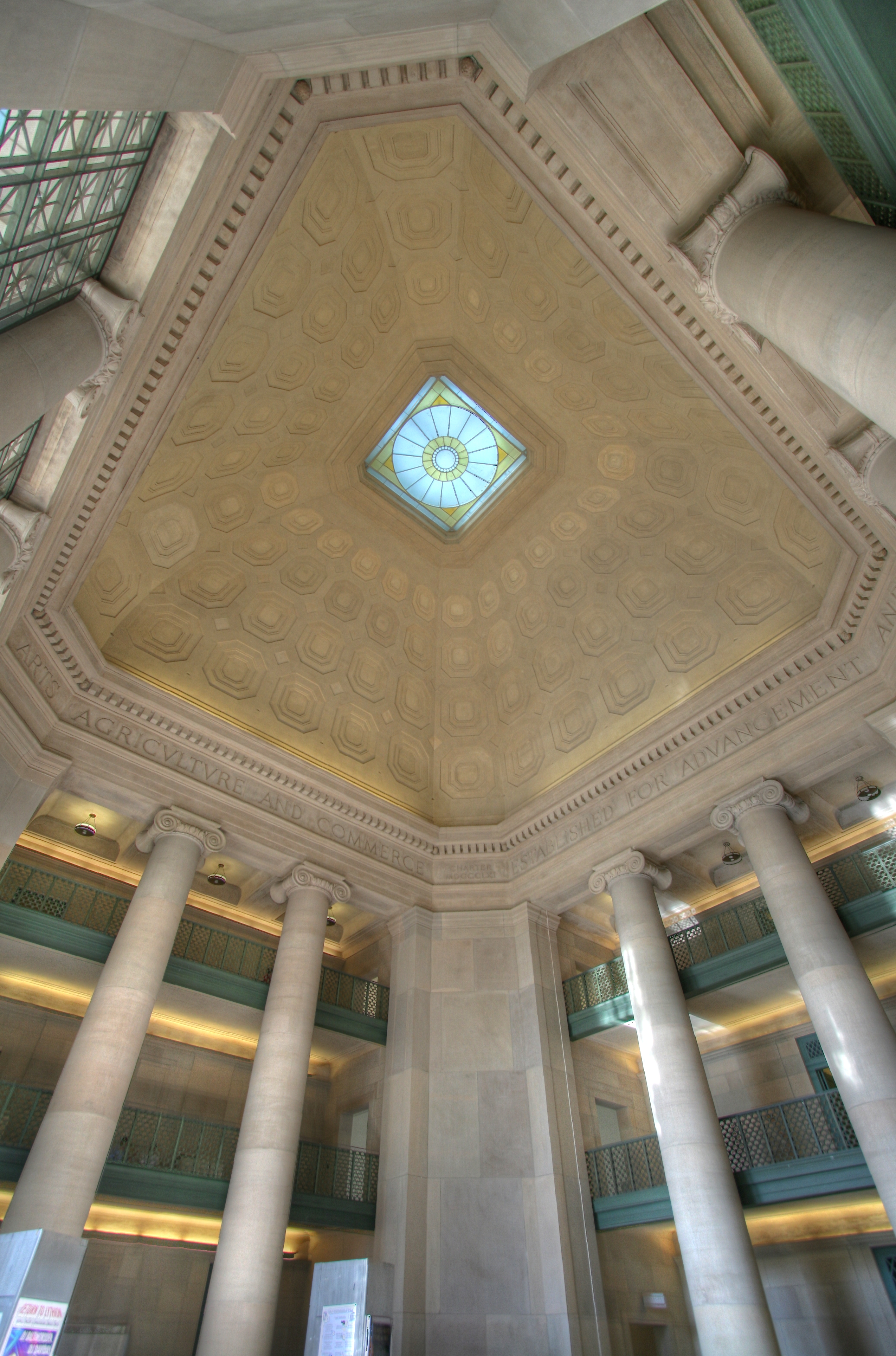
caption = Building 7 atrium
former_names = Building 7
building_type = Academic offices
architectural_style = Beaux-arts
location = 77 Massachusetts Avenue)
current_tenants = School of Architecture, MIT Corporation
coordinates =
start_date =
completion_date = 1939
demolition_date =
height =
other_dimensions =
floor_count = 7
floor_area =
architect = Bosworth & Carlson
awards = Building 7, which is adjacent to Massachusetts Avenue, is the official address of the entire Institute and as the entrance to theInfinite Corridor , the main artery connecting east campus with west campus. Building 7 was not a part of the original campus, but built as a part of MIT's expansion along Massachusetts Avenue. The lobby (named Lobby 7 after its building number) is an impressive vestibule topped by a small dome that rejects the neoclassical tradition of reducing scale between the interior and exterior with the result that the "inner space remains at the less intimate urban scale." The glassoculus at the top was blacked out duringWorld War II but was restored during a renovation in 2000.Fact|date=April 2007War and post-war buildings (1940-1960)
Alumni Pool
Infobox building
building_name = Alumni Pool
caption =
former_names = Building 57
building_type = Indoor swimming pool
architectural_style = Modern, International Style
location =
current_tenants = Dept. of Athletics, Physical Education, and Recreation
coordinates =
start_date =
completion_date = 1940
demolition_date =
height =
other_dimensions =
floor_count =
floor_area =
architect =Lawrence B. Anderson ,Herbert L. Beckwith
awards = The Alumni Pool (Building 57) was designed byLawrence B. Anderson (M.Arch. '30) and Herbert L. Beckwith (’26). The building was one of the first significant examples ofmodernist , International Style design in the United States by a US trained architect. In 2000, during the building of theStata Center , the building was restored and most of elegant modernist detailing was replaced by clumsy updates. The sophisticated color palette of the interior floor and walls disappeared. Its walled-in garden to the south was removed altogether. Nonetheless, the building still retains much of its early modernist sensibility, unornamented surfaces and simple functional design. [ [http://www-tech.mit.edu/V114/N20/anderson.20n.html Lawrence B. Anderson - The Tech ] ]Building 20
Infobox building
building_name = Building 20
caption =
former_names =
building_type = Academic offices and laboratories
architectural_style =
location =
current_tenants =
coordinates =
start_date =
completion_date = 1942
demolition_date = 1996
height =
other_dimensions =
floor_count =
floor_area =
architect =
awards = Building 20 was erected hastily during World War II as a temporary building that housed the historic Radiation Laboratory. Over the course of fifty-five years, its "temporary" nature allowed research groups to have more space, and to make more creative use of that space, than was possible in more respectable buildings. Professor Jerome Y. Lettvin once quipped, "You might regard it as the womb of the Institute. It is kind of messy, but by God it is procreative!" [cite journal
last=Garfinkel
first=Simpson
title=Building 20: The Procreative Eyesore
journal=Technology Review
volume=94
issue=November/December 1991
pages=MIT11] [ [http://libraries.mit.edu/archives/mithistory/building20/quotes.html#lettvin Quotes and Stories about Building 20] ] The structure was removed to make way for theStata Center .Westgate (1945 & 1963)
Infobox building
building_name =
caption =
former_names =
building_type =
architectural_style =
location =
current_tenants =
coordinates =
start_date =
completion_date =
demolition_date =
height =
other_dimensions =
floor_count =
floor_area =
architect =
awards = Westgate was established to provide student housing for the large numbers of veterans returning to study afterWorld War II . The demand for housing was unprecedented both in quantity as well as in the qualities that students often were married or had children to care for. The community persisted for over a decade before the decision was made to create more permanent housing for married students.The current Westgate married students housing was completed in 1963.
Baker House
Infobox building
building_name = Baker House

caption = Detail of Baker House facade onto theCharles River
former_names =
building_type =
architectural_style =
location = 362 Memorial Drive
current_tenants =
coordinates =
start_date =
completion_date = 1949
demolition_date =
height =
other_dimensions =
floor_count = 6
floor_area =
architect = Alvar Aalto
awards =Alvar Aalto , a Finnish architect, designed Baker House. It has an undulating shape which allows most rooms a view of theCharles River , and gives many of the rooms a wedge layout. Aalto also designed furniture for the rooms.Building 14 (1950)
Infobox building
building_name =
caption =
former_names =
building_type =
architectural_style =
location =
current_tenants =
coordinates =
start_date =
completion_date =
demolition_date =
height =
other_dimensions =
floor_count =
floor_area =
architect =
awards = Building 14, which includes the Charles Hayden Memorial Library, is located adjacent to Building 2 along Memorial Drive. Built in response to the Lewis Committee findings, it originally housed all of the humanities faculty, although growth of these departments has since required more space. The building features large bay-windows overlooking both the Charles River to the south and Eastman Courtyard to the north as well as high ceilings.cite web|url=http://libraries.mit.edu/humlib/#history |title=HASS Committee on the Humanities Library |date=2000 |accessdate=2007-05-08]MIT Chapel Infobox building
building_name = Chapel
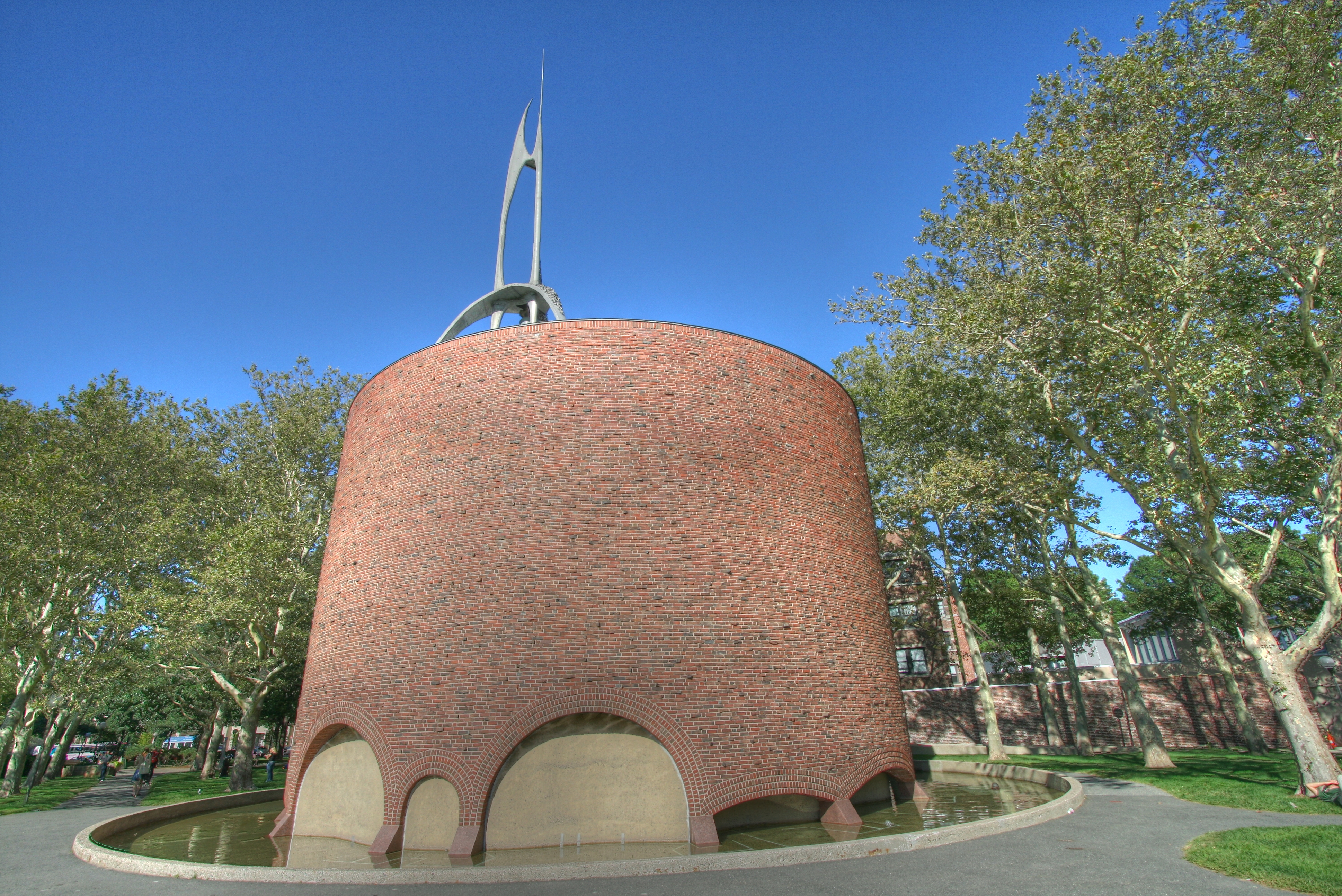
caption = MIT Chapel
former_names = Building W15
building_type = Church
architectural_style = Modern
location = 48 Massachusetts Ave.
current_tenants =
coordinates =
start_date =
completion_date = 1955
demolition_date =
height = convert|33|ft|m|0
other_dimensions =
floor_count = 2
floor_area =
architect = Eero Saarinen
awards =Eero Saarinen designed the non-denominational MIT Chapel. The chapel consists on the outside of a plain brick cylinder convert|33|ft|m tall, topped with an aluminum bell tower. The building is encircled by a shallow moat, that defines it as an island of serenity. Reflections from the water bounce up into the interior of the chapel through hidden windows. On the interior, Saarinen created undulating walls that focus on the chapel's altar. The dramatic modern style initially shocked theKresge Auditorium Infobox building
building_name = Kresge Auditorium
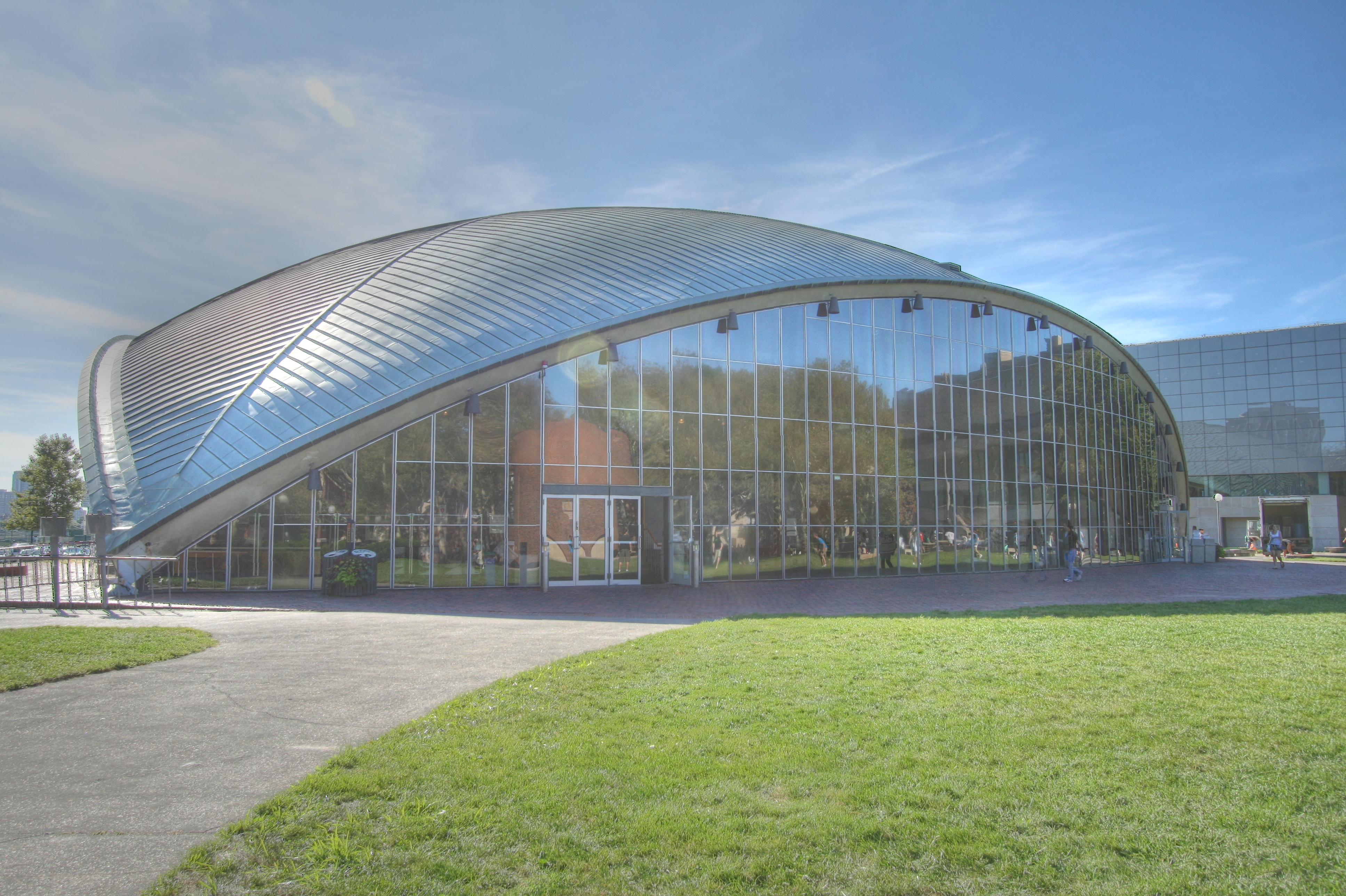
caption = Exterior of Kresge Auditorium looking west
former_names = Building W16
building_type = Auditorium
architectural_style = Modern
location =
current_tenants =
coordinates =
start_date =
completion_date = 1955
demolition_date =
height =
other_dimensions =
floor_count = 3
floor_area =
architect = Eero Saarinen
awards = The Auditorium was intended as a type of university meeting hall, those words being, in fact, inscribed over the entrance.econd Century Fund (1960-1990)
Over the years, MIT has made an effort to bring noted architects to campus for particular commissions. The period between 1960 and 1990 was marked by a drastic increase in the size of the campus (
McCormick Hall (1963)
Infobox building
building_name =
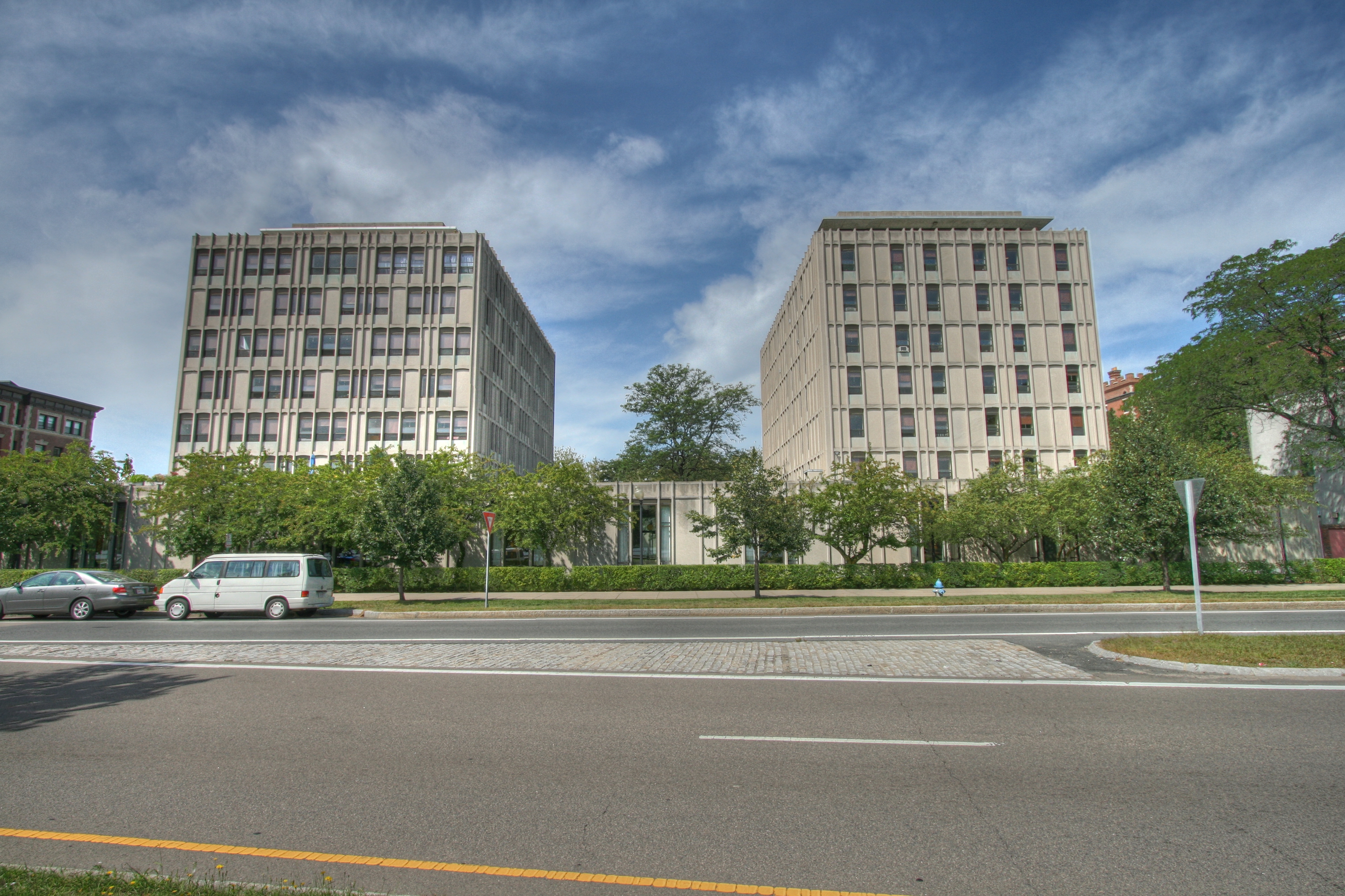
caption =
former_names =
building_type =
architectural_style =
location =
current_tenants =
coordinates =
start_date =
completion_date =
demolition_date =
height =
other_dimensions =
floor_count =
floor_area =
architect =
awards = Although women had been enrolling at MIT since the 1880s, they constituted a tiny minority of the total undergraduate population and lived in a town house across the river. In 1959, MIT released a report, "The Woman at MIT", which outlined the need to expand residential and social opportunities for female students.Harvard reference|last=Simha |first=O. Robert |title=MIT Campus Planning 1960-2000: An Annotated Chronology |year=2001 |place=Cambridge, MA |publisher=MIT Office of the Executive Vice President |location=Cambridge, MA |p=32-34] In 1960,Katharine Dexter McCormick '04 pledged $1.5 million towards the construction of an on-campus female dormitory.Professor
Herbert L. Beckwith was named architect of the project and he proposed a pair of towers along between Memorial Drive and the Kresge Court. Construction required the relocation of a Catholic nursing order, busy parking lot, and existing student housing and was broken into two phases: the West Wing was completed in 1963 and the East Wing was completed in 1968. The towers are connected by public spaces like a dining hall, dance studio, and music room at the ground floor. The building has attracted some criticism for its inefficient use of space but was renovated in the late 1990s. [The building sits on convert|2.5|acre|m2 but its convert|132000|sqft|m2|-2 only houses 250 students.]Hermann Building (1965)
Infobox building
building_name =
caption =
former_names =
building_type =
architectural_style =
location =
current_tenants =
coordinates =
start_date =
completion_date =
demolition_date =
height =
other_dimensions =
floor_count =
floor_area =
architect =
awards = The Grover M. Hermann Building (E53) houses Dewey Library and the Department of Political Science. As the Sloan School of Management expanded like other departments after the war, it quickly faced a shortage of space in its original building at 50 Memorial Drive (E52) which was only acquired in 1952.Harvnb|Simha|2001|pp=51-52] ProfessorEduardo F. Catalano prepared a Sloan Campus Plan incorporating a plaza connecting a new academic building, Building E52, and parking. Grover Hermann of theMartin Marietta Company contributed funds for the four-story building set on aplinth . The building has been criticized by its inhabitants for its lack of natural light and "fortress architecture."Eastgate (1967)
Infobox building
building_name =
caption =
former_names =
building_type =
architectural_style =
location =
current_tenants =
coordinates =
start_date =
completion_date =
demolition_date =
height =
other_dimensions =
floor_count =
floor_area =
architect =
awards = Eastgate (E55) completed and first occupied in August 1967. The building hosts family housing (students with spouses/partners and/or children) as well as a day care center.tratton Student Center (1968)
Infobox building
building_name =

caption =
former_names =
building_type =
architectural_style =
location =
current_tenants =
coordinates =
start_date =
completion_date =
demolition_date =
height =
other_dimensions =
floor_count =
floor_area =
architect =
awards = Walker Memorial had originally served as the home for many student activity groups for several decades, but the growing post-war student population required the construction of a new and larger building. The first proposals originated in 1955 after the opening of Kresge Auditorium and Chapel had firmly planted MIT's presence on the other side of Massachusetts Avenue. Saarinen was again retained again to design the new structure, but was dropped after his proposal met with resistance from faculty and donors.Harvnb|Simha|2001|p=26-29]Professor
Eduardo F. Catalano replaced Saarinen in 1961 and proposed a structure that would house meeting and practice rooms as well as commercial areas like a post office, tailor, barbershop, and bowling alley. The proposed building was a monumentally imposing structure representing a high form ofbrutalism and included large glass windows, balconies, and terraced staircases. The building was approved in 1963 and dedicated to outgoing PresidentJulius A. Stratton in 1965. Although initially well received, the complex design of the interior, a lack of storage space, heavy use by students, and austere exterior lead to a major renovation in the late 1980s. [Dackiw and Mein cited three major problems with the Student Center's present design: unclear traffic flow and arrangement; "dark and unwelcoming"parts of the interior; and overused and underused spaces. Mein said he would like to change the entrance "dramatically. The central area needs more light and more obvious activity"
cite web |url=http://www-tech.mit.edu/archives/VOL_103/TECH_V103_S0881_P008.pdf |title=Architects envision new Student Center |date=1983-12-13 |accessdate=2007-04-09 |author=Janice M. Elsen |publisher=The Tech]I.M. Pei
I. M. Pei & Partners designed a number for MIT buildings. Pei was a graduate from MIT's Department of Architecture (class of '40). Pei also designed the master plan for the southeast corner of the central campus.Green Building (1964)
Infobox building
building_name = Green Building

caption = The Green Building behind a sculpture, The Great Sail.
former_names = Building 54
building_type = Academic offices and classrooms
architectural_style = Modern
location = 21 Ames St.
current_tenants = Dept. of Earth, Atmosphere, and Planetary Sciences
coordinates =
start_date =
completion_date = 1964
demolition_date =
height = convert|295|ft|m|0|abbr=on.
other_dimensions =
floor_count = 23
floor_area = convert|7200|sqft|m2|-1|abbr=on.
architect =I. M. Pei & Partners
awards = By the late 1950s as many smaller, but rapidly growing, departments were outgrowing their spaces, ProfessorRobert R. Shrock solicitedCecil H. Green '23, the founder ofTexas Instruments , for a new building to house the geology and meteorology departments in a new Center for Earth Sciences. As Bosworth's plans for residential life on East Campus had not been realized, many departments had aspirations for utilizing the open space in Eastman Court. Pei andHideo Sasaki proposed siting the building in East Campus and breaking MIT's architectural tradition of "horizontality"Harvnb|Simha|2001|p=30-31]The tower would rise 21 stories to convert|295|ft|m|0, breaking Cambridge's previous convert|80|ft|m|0|sing=on restriction on building height. However, every floor measures only 60 by 120 feet (18 by 36m) which research groups quickly outgrew and had to be accommodated elsewhere in the Institute. The height of the building and its relative proximity to the river also increased wind loads at its base, which prevented people from entering or leaving the building through the main doors on windy days. It is incorrectly [cite web|url=http://www-tech.mit.edu/V126/N36/36artsinterview.html |title=List Curators Discuss Evolving Face of Public Art by Benjamin P. Gleitzman. The Tech, Sept. 8th, 2006. Interview with curators Bill Arning and Patricia Fuller.] rumored that
Alexander Calder 's "Big Sail", situated in front of the building, is meant to deflect these winds. The height of the building The Green Building remains the only academic tower on campus and faculty insistence as well as logistical realities have continued MIT's "horizontal continuity."Dreyfus Building
Infobox building
building_name = Dreyfus Building
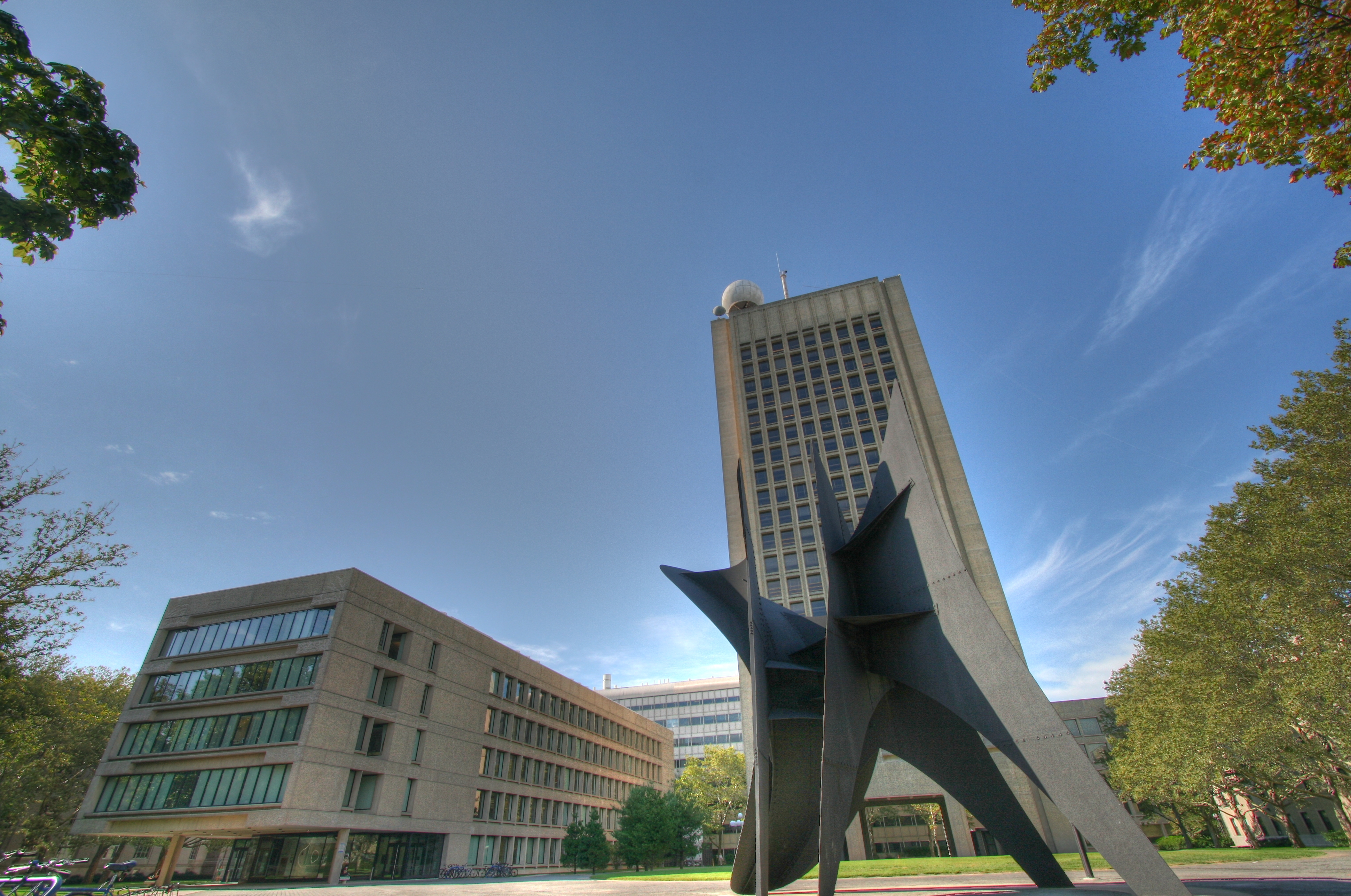
caption =
former_names = Building 18
building_type = Research laboratories and offices
architectural_style = Modern
location = 21 Ames St.
current_tenants = Dept. of Chemistry
coordinates =
start_date =
completion_date = 1977
demolition_date =
height =
other_dimensions =
floor_count =
floor_area = 8
architect =I. M. Pei & Partners
awards = TheCamille Edouard Dreyfus Building (Building 18) houses the Chemistry Department. The building parallels Eastman Laboratory (Building 6) to the east and architecturally evokes a horizontal version of the Green Building which lies to its east. Although it deviates from MIT's traditional central corridor scheme by placing the laboratory and office space away from the windows by means of exterior corridors.Harvnb|Simha|2001|pp=54-56] The interior space consisted of a research community of graduate students working in laboratory modules at the center and faculty offices, lobbies, and teaching areas at each end of the building. A major renovation to the convert|132000|sqft|m2|-2|sing=on building was completed in 2003. [cite web|url=http://web.mit.edu/evolving/buildings/chemistry/index.html |title=Dreyfus Chemistry Building (18) Renovation |publisher=MIT Evolving Campus |accessdate=2007-04-11]Landau Building
Infobox building
building_name = Landau Building

caption = The Landau Building from Ames St. looking west.
former_names = Building 66
building_type = Research laboratories and classrooms
architectural_style = Modern
location = 25 Ames St.
current_tenants = Dept. of Chemical Engineering
coordinates =
start_date =
completion_date = 1976
demolition_date =
height =
other_dimensions =
floor_count = 9
floor_area =
architect =I. M. Pei & Partners
awards = The Landau Building (Building 66) houses the Chemical Engineering Department. convert|130000|sqft|m2|-3. [cite web|url=http://web.mit.edu/CHEME/che/facilities.html |title=ChemE Overview |accessdate=2007-03-27]Wiesner Building (1985)
Infobox building
building_name = Wiesner Building
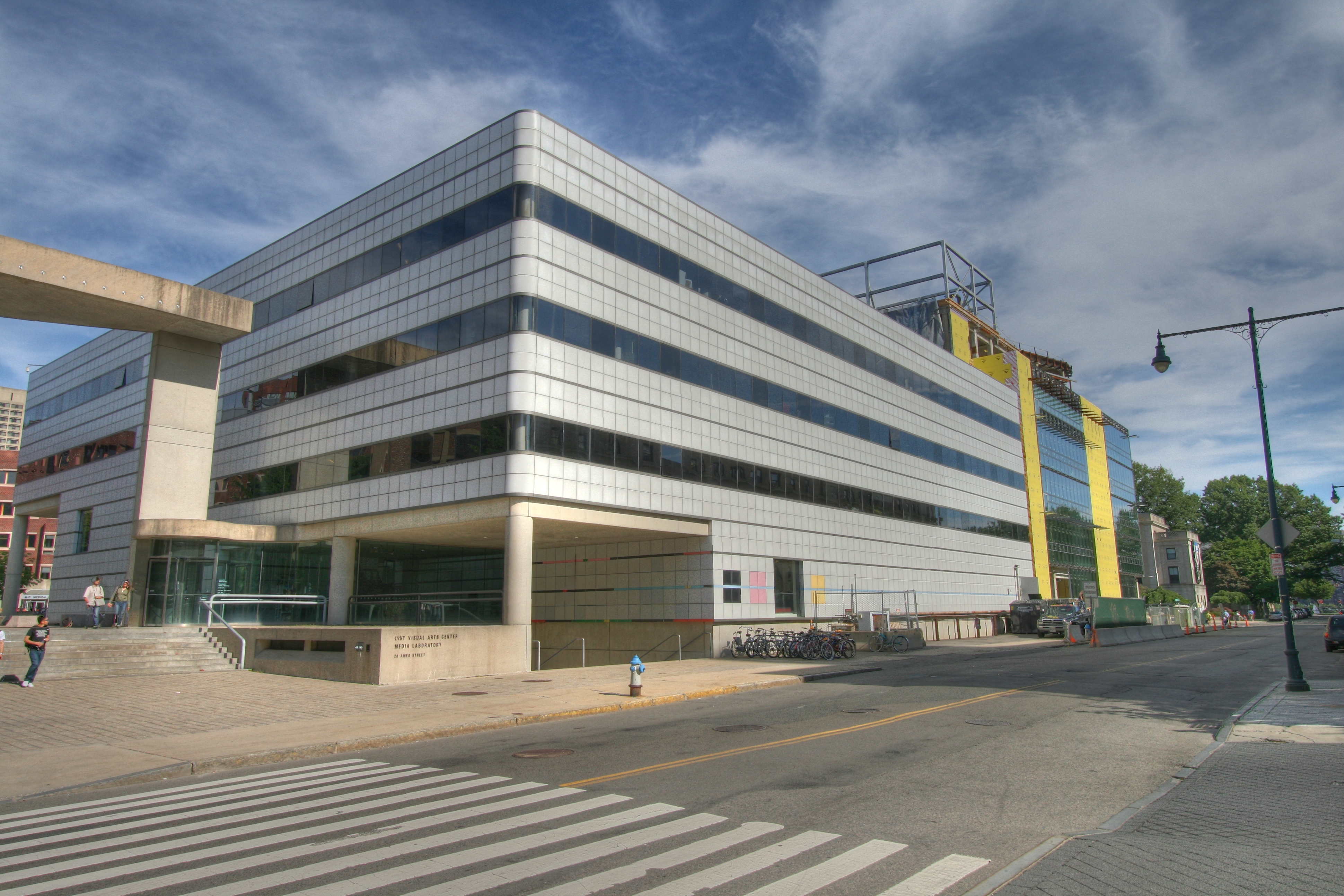
caption = MIT Media Laboratory from Ames St. looking east.
former_names = Building E15
building_type = Research laboratories
architectural_style = Modern
location = 20 Ames St.
current_tenants = Media Laboratory
coordinates =
start_date =
completion_date = 1985
demolition_date =
height =
other_dimensions =
floor_count = 6
floor_area =
architect =I. M. Pei & Partners
awards = The Wiesner building (Building E15) houses theMIT Media Lab and the List Visual Arts Center and is named in honor of former MIT presidentJerome Wiesner and his wife Laya. The building is very box-like, a motif that is consistently repeated in both the interior and exterior design evoking a sense of boxes packed within each other.Harvnb|Cambell and Cruikshank|1985|pp=11-12]The building is notable for the level of collaboration between the architect and artists. It stands apart from the surrounding neighborhood with is flat, gridded skin make of white, modular metal panels. The building's exterior was designed by
Kenneth Noland is meant as a metaphor of technology through the grids of graph paper and number matrices while also quoting the corridor-like morphology of the rest of the MIT campus.Scott Burton ,Alan Shields , andRichard Fleischner also collaborated extensively in the final design of the internal atria and external landscaping.Dormitories
From [http://libraries.mit.edu/archives/mithistory/housing.html MIT Housing Chronology]
*1960: Burton-Conner Dining Room
*1968: Random Hall (NW61) opened. Undergraduate and graduate housing.
*1970: MacGregor House (W61) first occupied in September 1970. Undergraduate housing.
*1973: Tang Hall (W84) first occupied in 1973. Single graduate housing.
*1975: New West Campus Houses (W70 - 471-476 Memorial Drive) completed and first occupied in 1975. Undergraduate housing includes Spanish, Russian, German and French Houses.
*1981: 500 Memorial Drive (W71) Next House completed and first occupied in August 1981. Undergraduate housing."Backyard"
Buildings 34-36-38 - pg.101Brown Building (Building 39) - pg.66Center for Advanced Engineering Study (Building 9) - pg. 59McNair Building (building 37) - pg. 57
Whitaker College
Infobox building
building_name = Whitaker College

caption =
former_names = Building E25
building_type = Academic offices and classrooms
architectural_style = Modern
location = 45 Carleton Street
current_tenants = Harvard-MIT Health Sciences and Technology, Whitaker College of Health Sciences and Technology
coordinates =
start_date =
completion_date = 1982
demolition_date =
height =
other_dimensions =
floor_count = 7
floor_area =
architect = Mitchell Giurgola Gruzen Partners
awards = Whitaker College (Building E25) houses the College of Health Sciences and Technology as well as MIT Medical.Johnson Athletics Center
Infobox building
building_name = Howard W. Johnson Athletics Center
caption =
former_names = Building W34
building_type = Gymnasium and indoor track
architectural_style = Modern
location = 120 Vassar Street
current_tenants = Department of Athletics, Physical Education, and Recreation
coordinates =
start_date =
completion_date = 1981
demolition_date =
height =
other_dimensions =
floor_count = 2
floor_area =
architect = Davis Brody
awards =Evolving Campus (1990-present)
A major building effort has been underway for several years in the wake of a $2 billion development campaign. For these commissions, MIT brought in leading architects to propose dramatic new buildings to contrast the earlier, more mundane buildings. [Harvnb|Gannon|2004|pp=25] The new buildings have created a good deal of debate, particularly in a city like Boston, which is not known for its contemporary architecture. Critics have both hailed and assailed the prominence of "starchitecture" on campus. [cite web |title=Starchitecture on Campus |url=http://www.boston.com/news/globe/magazine/articles/2004/02/22/starchitecture_on_campus/ |accessdate=2006-10-24]
Koch Biology Building
Infobox building
building_name = Koch Biology Building
caption =
former_names = Building 68
building_type = Research laboratory
architectural_style = Modern
location = 31 Ames Street
current_tenants = Department of Biology
coordinates =
start_date =
completion_date = 1994
demolition_date =
height =
other_dimensions =
floor_count = 8
floor_area =
architect = Goody & Clancy Associates
awards = 68Tang Center for Management Education
Infobox building
building_name = Tang Center

caption = Tang Center.
former_names = Building E51
building_type = Academic offices and classrooms
architectural_style = Modern
location = 70 Memorial Drive
current_tenants = Sloan School of Management, School of Humanities, Arts, and Social Sciences
coordinates =
start_date =
completion_date = 1995
demolition_date =
height =
other_dimensions =
floor_count = 4
floor_area =
architect = Ellenzweig
awards = E51Zesiger Sports and Fitness Center
Infobox building
building_name = Zesiger Sports and Fitness Center

caption = The "Z-center."
former_names = Building W35, Z-center
building_type = Gymnasium
architectural_style = Modern
location = 120 Vassar Street
current_tenants = Department of Athletics, Physical Education, and Recreation
coordinates =
start_date =
completion_date = 2002
demolition_date =
height =
other_dimensions =
floor_count = 5
floor_area =
architect =Kevin Roche and John Dinkeloo & Associates
awards = TheZesiger sports and fitness center (Z-Center), featuring an Olympic-class swimming pool, designed byKevin Roche and John Dinkeloo & Associates, (2002).immons Hall
Infobox building
building_name = Simmons Hall

caption = Simmons Hall.
former_names = Building W79
building_type = Dormitory
architectural_style = Post-modern
location = 229 Vassar Street
current_tenants = Undergraduate residences
coordinates =
start_date = 1999
completion_date = 2002
demolition_date =
height =
other_dimensions =
floor_count = 10
floor_area =
architect =Steven Holl and Associates, Perry Dean Rogers
awards = After the alcohol-related death of an MIT freshman living in an off-campus fraternity in 1998, the MIT administration settles the resulting lawsuit under the stipulation that all freshmen will be required to live on campus. The decision means that MIT needs beds for 300 freshmen who previously would have lived in off-campus fraternities, sororities, and independent living groups.Steven Holl and Associates were chosen to lead the design for a new "porous" dormitory in 1999.Harvnb|Gannon|2004|pp=7] Simmons Hall opened in August 2002 for student occupancy.The building has 350 student rooms, convert|55382|ft|m|0|sing=on by convert|2|ft|m|0|sing=on windows, and is constructed of 291 precast, steel-reinforced
Perfcon panels.tata Center
Infobox building
building_name = Ray and Maria Stata Center
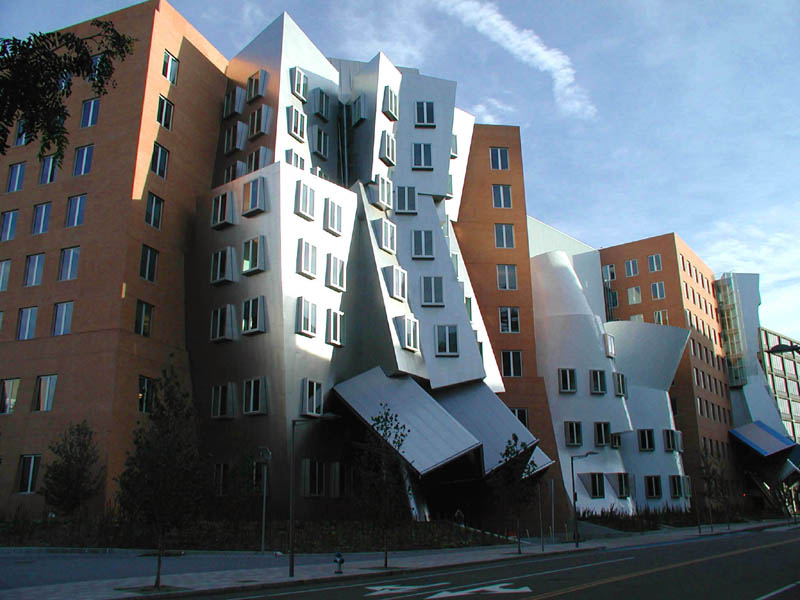
caption =
former_names = Building 32
building_type =
architectural_style = Post-modern
location = 32 Vassar Street
current_tenants =MIT Computer Science and Artificial Intelligence Laboratory , Department of Linguistics and Philosophy
coordinates =
start_date = 1998
completion_date = 2004
demolition_date =
height =
other_dimensions =
floor_count =
floor_area =
architect =Frank Gehry
awards = TheStata Center Brain and Cognitive Sciences complex
Infobox building
building_name = Building 46

caption =
former_names =
building_type = Research laboratory
architectural_style = Modern
location = 43 Vassar Street
current_tenants = Department of Brain and Cognitive Science, Picower Institute for Learning and Memory, cGovern Institute for Brain Research
coordinates =
start_date =
completion_date = 2006
demolition_date =
height =
other_dimensions =
floor_count =
floor_area =
architect =Charles Correa and Goody, Clancy and Associates
awards = Building 46, which houses thePicower Institute for Learning and Memory , the Department of Brain and Cognitive Science, and theMcGovern Institute for Brain Research .Landscaping
As MIT's riverfront site was a marshland filled-in by dredging from the bottom of the Charles, it was largely free from either natural flora or previous occupants. In 1892, the Cambridge Park Commission had commissioned
Frederick Law Olmsted to lay out a picturesque driveway and park along the Charles River that would feature tree-lined promenades and a central mall. Bosworth's plan would integrate thisMemorial Drive (Cambridge) into the campus by using courtyards enclosed and overlooked by the academic buildings. Killian (née Great) Court, the main entrance, was originally planned by Mabel Babcock '08 to be a French-style gravel-covered court centered around a large statue ofMinerva . However, as automobile and trolley traffic along Massachusetts Avenue made the western buildings the "de facto" entrance to MIT, the Great Court was replaced by "street-edge plantings of low privet hedges, a line of oak trees, lawns and base plantings to create a visual transition from the ground level over the English basement to the first floor of the new buildings."Harvnb|Simha|2001|pp=18-19] TheNew England Hurricane of 1938 andDutch Elm Disease required that many of the original trees in Killian be replaced by pin oaks.Temporary buildings constructed during and immediately after World War II occupied many vacant lots around MIT, but the 1960 Campus Master Plan included
Hideo Sasaki as a landscape architect. The Landscape Master Plan called for "tree-lined and landscaped streets and pathways; well-defined open spaces, each reflecting the designs and functions of the buildings in each campus sector; and a variety of tree species to safeguard the campus against the blights that strike monocultures."Artwork
Like many colleges and universities, the Massachusetts Institute of Technology has sculptures and other art-related installations scattered across its campus.
References
Further reading
*Harvard reference|last=Jarzombek |first=Mark |authorlink=Mark Jarzombek |title=Designing MIT: Bosworth's New Tech |place=Boston |year=2004 |publisher=Northeastern University Press
*Harvard reference|last=Gannon |first=Todd |title=Steven Holl: Simmons Hall |publisher=Princeton Architectural Press |place=New York |year=2004
*Harvard reference|last=Simha |first=O. Robert |title=MIT Campus Planning 1960-2000: An Annotated Chronology |publisher=MIT Office of the Executive Vice President |place=Cambridge, MA |year=2001
*Harvard reference |last1=Campbell |first1=Robert |last2=Cruikshank |first2=Jeffrey |title=Artists and Architects Collaborate: Designing the Wiesner Building |publisher=MIT Committee on the Visual Arts |year=1985
Wikimedia Foundation. 2010.
